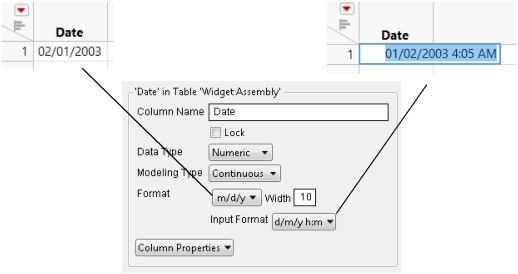Change Date-Time Values in Data Tables
In data tables, JMP can accept the input of date-time values in one format (the input format), store them internally as the number of seconds since the base date, and display them in a different date-time format. The Informat() and Format() functions give you this control.
• Informat() takes a string date-time value, defines the date format used in that string, and returns the date in ddMonyyyy format.
Informat( "19May2011 11:37:52 AM", "ddMonyyyy h:m:s" );
19May2011:11:37:52
• Format() takes the number of seconds since the base date (or a date-time function that returns that number) and returns the date in the specified format.
Format( 3388649872, "ddMonyyyy h:m:s" );
"19May2011 11:37:52 AM"
Format( Today(), "ddMonyyyy h:m:s" );
"19May2011 11:37:52 AM"
Suppose that you are entering dates into a column using the d/m/y h:m format, but you want to see the dates in the m/d/y format. Input Format defines the input format, and Format defines the display format. For example,
New Table( "Widget Assembly",
Add Rows( 1 ),
New Column( "Date",
Numeric,
"Continuous",
Format( "m/d/y" ),
Input Format( "d/m/y h:m" ),
Set Values( [3126917100] )
)
);
The Format and Input Format values are shown in the data table’s column properties (Figure 6.3). Note that when you click in the cell to edit it, the date-time value appears in the input format. When you edit the value, or add a new value, the format specified in the data table column Format list is used to display the value.
Figure 6.3 Example of Date-Time Display and Input Values
Notes:
• In a script that converts a column from character to numeric, specify Format() and Informat() to prevent missing values. See Convert Character Dates to Numeric Dates.
• The date-separator character on your computer might differ from the forward slash (/) character shown in the Scripting Guide.
• You can enter time values in 24-hour format (military time) or with AM or PM designators.
Table 6.4 describes the formats used as arguments in date-time functions or as data table formats. You can also use the formats for the format argument to a Format message to a data column. See Set or Get Formats.
For descriptions of specific date-time functions, see Date and Time Functions in the JSL Syntax Reference.
Notes:
• Date-time formats in which a colon or T separate the date and time always use a 24-hour format. Other formats use your computer’s regional settings.
• If the format is unknown, an error is written to the log.
Type | Format argument | Example |
|---|---|---|
Date only | "m/d/y" | "01/02/1999" |
| "mmddyyyy" | "01021999" |
| "m/y" | "01/1999" |
| "d/m/y" | "02/01/1999" |
| "ddmmyyyy" | "02011999" |
| "ddMonyyyy" | "02Jan1999" |
| "Monddyyyy" | "Jan021999" |
| "y/m/d" | "1999/01/02" |
| "yyyymmdd" | "19990102" |
| "yyyy-mm-dd" | “1999-01-02“ |
| "yyyyQq" | 1999Q1 |
Date and time | "m/d/y h:m" | "01/02/1999 13:01" "01/02/1999 1:01 PM" |
| "m/d/y h:m:s" | "01/02/1999 13:01:55" "01/02/1999 1:01:55 PM" |
| "d/m/y h:m" | "02/01/1999 13:01" "02/01/1999 1:01 PM" |
| "d/m/y h:m:s" | "02/01/1999 13:01:55" "02/01/1999 1:01:55 PM" |
| "y/m/d h:m" | ‘1999/01/02 13:01’ ‘1999/01/02 1:01 PM’ |
| "y/m/d h:m:s" | ‘1999/01/02 13:01:02 ‘1999/01/02 1:01:02 PM’ |
| "ddMonyyyy h:m" | "02Jan1999 13:01" "02Jan1999 1:01 PM" |
| "ddMonyyyy h:m:s" | "02Jan1999 13:01:02" "02Jan1999 1:01:02 PM" |
| "ddMonyyyy:h:m" | "02Jan1999:13:01" "02Jan1999:1:01 PM" |
| "ddMonyyyy:h:m:s" | "02Jan1999:13:01:02" "02Jan1999:1:01:02 PM" |
| "Monddyyyy h:m" | "Jan021999 13:01" "Jan021999 1:01 PM" |
| "Monddyyyy h:m:s" | "Jan021999 13:01:02" "Jan021999 1:01:02 PM" |
Day number and time | ":day:hr:m" | "34700:13:01" ":33:001:01 PM" |
| ":day:hr:m:s" | "34700:13:01:02" ":33:001:01:02 PM" |
| "h:m:s" | "13:01:02" "01:01:02 PM" |
| "h:m" | "13:01" "01:02 PM" |
| "yyyy-mm-ddThh:mm" | 1999-01-02T13:01 |
| "yyyy-mm-ddThh:mm:ss" | 1999-01-02T13:01:02 |
Duration | ":day:hr:m" | “52:03:01” reads fifty-two days, three hours, and one minute |
| ":day:hr:m:s" | “52:03:01:30” reads fifty-two days, three hours, one minute, and thirty seconds |
| "hr:m" | “17:37” reads seventeen hours and thirty-seven minutes |
| "hr:m:s" | “17:37:04” reads seventeen hours, thirty-seven minutes, and 4 seconds |
| "min:s" | “37:04” reads thirty-seven minutes and 4 seconds |
Note: The following formats display the date-time according to your computer’s regional settings. They are available only for the display of dates, not for date input in a data table. Examples are shown for the United States locale. | ||
Abbreviated date | "Date Abbrev" | (Display only) “01/02/1999" |
Long date | "Date Long" | (Display only) "Saturday, January 02, 1999" |
Locale date | “Locale Date” | (Display only) “01/02/1999" |
Locale date and time | “Locale Date Time h:m” | (Display only) “01/02/1999 13:01“ or “01/02/1999 01:01 PM“ |
“Locale Date Time h:m:s” | (Display only) “01/02/1999 13:01:02“ or “01/02/1999 01:01:02 PM“ | |
